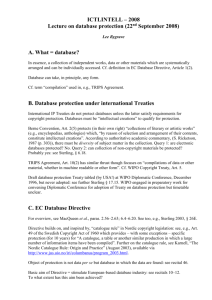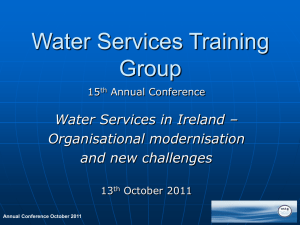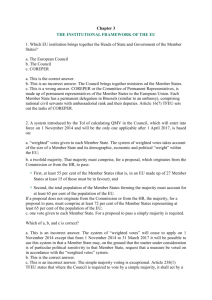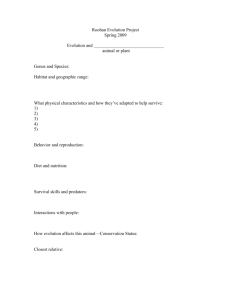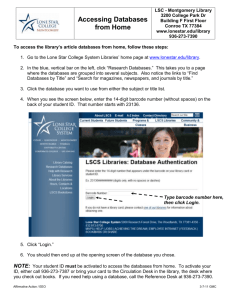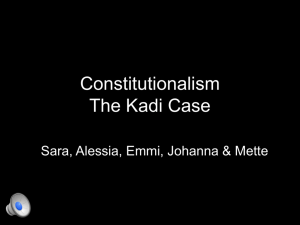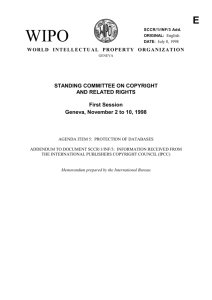Database protection
advertisement
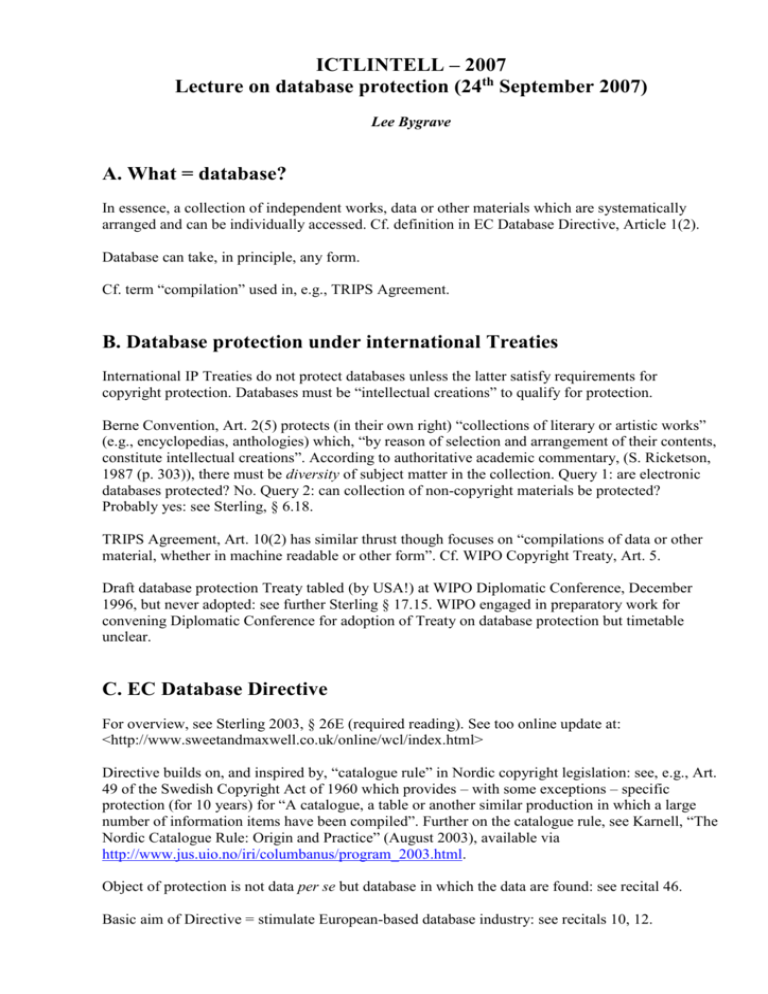
ICTLINTELL – 2007 Lecture on database protection (24th September 2007) Lee Bygrave A. What = database? In essence, a collection of independent works, data or other materials which are systematically arranged and can be individually accessed. Cf. definition in EC Database Directive, Article 1(2). Database can take, in principle, any form. Cf. term “compilation” used in, e.g., TRIPS Agreement. B. Database protection under international Treaties International IP Treaties do not protect databases unless the latter satisfy requirements for copyright protection. Databases must be “intellectual creations” to qualify for protection. Berne Convention, Art. 2(5) protects (in their own right) “collections of literary or artistic works” (e.g., encyclopedias, anthologies) which, “by reason of selection and arrangement of their contents, constitute intellectual creations”. According to authoritative academic commentary, (S. Ricketson, 1987 (p. 303)), there must be diversity of subject matter in the collection. Query 1: are electronic databases protected? No. Query 2: can collection of non-copyright materials be protected? Probably yes: see Sterling, § 6.18. TRIPS Agreement, Art. 10(2) has similar thrust though focuses on “compilations of data or other material, whether in machine readable or other form”. Cf. WIPO Copyright Treaty, Art. 5. Draft database protection Treaty tabled (by USA!) at WIPO Diplomatic Conference, December 1996, but never adopted: see further Sterling § 17.15. WIPO engaged in preparatory work for convening Diplomatic Conference for adoption of Treaty on database protection but timetable unclear. C. EC Database Directive For overview, see Sterling 2003, § 26E (required reading). See too online update at: <http://www.sweetandmaxwell.co.uk/online/wcl/index.html> Directive builds on, and inspired by, “catalogue rule” in Nordic copyright legislation: see, e.g., Art. 49 of the Swedish Copyright Act of 1960 which provides – with some exceptions – specific protection (for 10 years) for “A catalogue, a table or another similar production in which a large number of information items have been compiled”. Further on the catalogue rule, see Karnell, “The Nordic Catalogue Rule: Origin and Practice” (August 2003), available via http://www.jus.uio.no/iri/columbanus/program_2003.html. Object of protection is not data per se but database in which the data are found: see recital 46. Basic aim of Directive = stimulate European-based database industry: see recitals 10, 12. Definition of database in Article 1(2): wide range of material may constitute database. Both electronic and non-electronic databases covered [cf. original proposal limited to electronic databases; rejected because distinction between electronic and non-electronic was too difficult to apply, not appropriate, and not in conformity with TRIPS and the then incipient WCT] Computer programs fall outside scope of Directive: Art. 1(3). Database Directive provides two-fold protection for databases: (i) Under copyright – if database = intellectual creation (Art. 3); copyright does not extend to database contents, only database as such. (ii) Sui generis protection – if database = a. result of “substantial investment” (by database maker) in b. “obtaining, verification or presentation” of its contents to prevent c. “extraction and/or re-utilisation” of d. “the whole or … substantial part” of the contents (Art. 7(1)). Substantial investment can be quantitative (i.e., money, “sweat”) or qualitative (i.e., know-how, expertise). If “substantiality” criterion in (d) not met, protection still available if: a. “repeated and systematic” extraction/re-utilisation (of insubstantial parts) which either b. “conflict with normal exploitation” (of database) or c. “unreasonably prejudice the legitimate interests” of database maker (Art. 7(5)). Term of protection under sui generis right = 15 years from completion of making of database (Art. 10(1)). Note “renewability” problem. Increasing amount of case law on sui generis right in Art. 7. See the online database on the Directive, its transposition into national law and ensuing case law at: http://www.ivir.nl/files/database/index.html. Many legal issues some of which are unresolved, including: What = “data or other materials”? How material are “materials”? Are “materials” to be limited to the immaterial? Can database concept extend to biobanks, seedbanks and other similar collections of physical/biological material? What = independent works etc.? See ECJ decisions below, espec. discussion in Fixtures Marketing v. OPAP (ECJ C-444/02), para. 29ff. What = “systematic” or “methodical” arrangement? Again, see Fixtures Marketing v. OPAP (ECJ C-444/02), para. 30ff. What = “individually accessible”? Again, see OPAP decision. What = “obtaining”? Does it cover generation/creation of data for inclusion in database (as well as collection of pre-existing data)? See ECJ decisions below. What = “substantial investment”? How substantial is “substantial”? And in relation to what? Must investment be directed specifically at making of database or can it be directed at another activity which has database creation as mere “spin-off”? Again, see ECJ decisions below. What = “substantial part”? Cf. “crown in the jewel” test adopted in Cadremploi v. Keljob (dec. by District Court (Tribunal de grande instance) Paris 5th Sept. 2001) – only 12% of data extracted but these were found to be most valuable and, hence, substantial part. Cf. English axiom: “What is worth copying is worth protecting”, referred to by Rostock Lower Court (Amtsgericht) in decision of 20th Feb. 2001. Apparently rejected in ECJ decisions below: 2 see espec. British Horseracing Board v. William Hill Organisation (ECJ C-203/02), para. 78. What = “extraction” and “re-utilisation”? Cf. Derpoet.de case (decision of District Court (Landgericht) Cologne, 2nd May 2001) in which framing of texts on website such that plaintiff’s banners were hidden = extraction. Note “spin-off” theory, particularly prevalent in Netherlands and amongst academic commentators – i.e., that investment must be directed specifically at database generation, in order for database to qualify for protection under Art. 7. See further Hugenholtz, “Program Schedules, Event Data and Telephone Subscriber Listings under the Database Directive: The ‘Spin-Off’ Doctrine in the Netherlands and elsewhere in Europe” (2003), available at http://www.ivir.nl/publications/hugenholtz/spinofffordham.html Quartet of cases decided by ECJ which address, inter alia, validity of “spin-off” theory: Fixtures Marketing v. Veikkaus (ECJ C-46/02) British Horseracing Board v. William Hill Organisation (ECJ C-203/02) Fixtures Marketing v. AB Svenska Spel (ECJ C-338/02) Fixtures Marketing v. OPAP (ECJ C-444/02) Basically, judgments implicitly support “spin-off” doctrine. Substantial investment in creating data that make up database is not relevant for application of Art. 7. Thus “single-source” data o/side scope of Art. 7. ECJ draws distinction between creating and obtaining data. Problematic? For critical analysis of the judgments, see M.J. Davison & P. Bernt Hugenholtz, “Football Fixtures, Horse Races and Spin-offs: The ECJ Domesticates the Database Right”, European Intellectual Property Review, 2005, vol. 27, issue 3; also available at <http://www.ivir.nl/publications/hugenholtz/EIPR_2005_3_databaseright.pdf>. D. Approaches outside EU – with focus on USA, Australia, Canada and Japan Point of departure No sui generis regime (as yet) for database protection in either USA, Japan, Canada or Australia. Such regimes unusual outside EU. Much scepticism in non-EU states about economic need for such regimes. See, e.g., US criticisms gathered at <http://www.umuc.edu/distance/odell/cip/links_database.html>. However, various attempts to introduce such regime in USA: see, e.g., Bill for Consumer and Investor Access to Information Act (introduced into Congress in 1999 but not enacted). Most recently, see Bill for Database and Collections of Information Misappropriation Act (introduced into Congress in August 2003; fate uncertain). For general overview of relevant Bills introduced into US Congress, see J. Band, “The database debate in the 108th US Congress: the debate continues” [2005] EIPR 205. Neither USA, Japan, Canada nor Australia (nor other non-EU states) obliged under international law to introduce such regime, cf. above. 3 Protection under copyright law In USA, Australia, Canada and Japan databases may qualify for protection as literary works, on the basis that they are “compilations”. See, e.g., Australia’s Copyright Act s. 10 – defining “literary work” to include “a table, or compilation, expressed in words, figures or symbols (whether or not in a visible form)”. Latter clause in parentheses intended to make clear that computerised databank can be a compilation: see Explan. Memo. to Copyright Amendment Bill 1984. Doubtful that film clips or music clips would be covered as these are not “expressed in words, figures or symbols”. For USA, see Copyright Act, 17 USC § 101 (defining “compilation”) & § 103 (extending copyright protection to compilations as form of literary work). For case law, see, e.g., Lane v. First National Bank of Boston, 687 F Supp 11 (DC Mass 1988). For Japan, see Copyright Act, Art. 12 (protecting compilations). However, under US, Australian, Canadian and Japanese law, for copyright to subsist in database (as compilation), the database must either: (a) contain original content; or (b) its creation must involve a certain degree of skill, judgement or ingenuity. Usually, databases will not have original content as data are factual. But they may satisfy criteria in (b). Issue then is what degree of skill etc is necessary? Is mere investment of time and resources sufficient? Leading US case = Feist Publications v. Rural Telephone Service Co. (1991) 499 US 111. Rejects “sweat of brow” doctrine. Cf. Australian courts – drawing upon English case law – tend to support “sweat of brow” doctrine. Leading case = Desktop Marketing Systems v. Telstra Corporation Limited [2002] FCAFC 112. Authorship requirement: under US and Australian copyright law, a work must usually have a human author. Other possible avenues of protection Contract Database owner attempts to enter into contract with potential users of its database, stipulating terms and conditions of use. Several problems with this strategy, particularly if effectuated by “click-wrap” clauses: e.g., is sufficient notice given of terms and conditions? See further my lecture notes on contract law and copyright. Passing off Tort of passing off intended to stop one party from misrepresenting their goods/services as being or having a connection with goods/services of another party. Protection of a business’ goodwill is main rationale for tort. See further Reckitt & Coleman Products Ltd v. Borden Inc. [1990]; Erven Warnink v. J. Townsend & Sons (Hull) Ltd. [1979]. 4 [Tort is only useful if competitor engages in misrepresentation/deceptive conduct] Trespass to chattels Plaintiff must show that defendant intentionally, and without authorisation, interfered with plaintiff’s possessory interest in its property. Physical contact required. US case law holds that electronic access meets this requirement: see eBay case below. In Australian law, actual damage to chattel arguably not required; intentional touching sufficient. In US law, there must be either dispossession, impairment of quality/value, or loss of use for substantial time. In present context, it is impairment of chattel’s quality or value which is most relevant. Leading US case of interest: eBay, Inc. v. Bidder’s Edge Inc. (2000). In Ticketmaster Corp. v Tickets.com, Inc. (2nd order of 10.8.2000), court agreed with line established in eBay, but distinguished the facts. Trade secrets Contents of database may be protected under tort or legislation on breach of trade secrets. Successful conviction usually requires that the compiler has made reasonable efforts to maintain secrecy. Criminal Action Application of criminal offences for unauthorised access of computer systems. Successful conviction usually requires proof “beyond reasonable doubt” which is more stringent than “balance of probabilities” threshold for civil actions. Unjust Enrichment The modern law of unjust enrichment has following elements: (i) Unjust behaviour; (ii) Enrichment of defendant; (iii) Either at expense of plaintiff and by subtraction from plaintiff; (iv) Or by doing wrong to plaintiff; (v) Where no defences are applicable. Little case law in USA, Canada or Australia applying unjust enrichment law to database extraction, but such law could play important role in the future. See further Fitzgerald & Gamertsfelder, “Protecting Informational Products (including databases) through Unjust Enrichment Law: An Australian Perspective”, European Intellectual Property Review, 1998, vol. 20, pp. 244–255. Unfair competition/commercial misappropriation Similar to “unjust enrichment” action. Plays a role in USA: see leading case of International News Service v. Associated Press (1918) 248 US 215. Business Patents Arguable that database system can be patented and therefore capable of protection as a business method patent – at least under US law. But online databases need to satisfy strict requirements for patent to succeed. For overview of problems and implications of patenting in online context, see, e.g., Grossfeld & Hoeltzenbein, “CyberLaw and CyberControl: Cyberspace Patents”, in Schweizer et al. (eds.), Festschrift für Jean Nicolas Druey (Zürich: Schulthess, 2002), pp. 755ff. 5 Broadcasting law In Japan, some digital databases may be protected under broadcasting legislation. E. Supplementary literature and sources (in addition to those mentioned above) M.J. Davison, The Legal Protection of Databases (Cambridge: Cambridge University Press, 2003). H.A. Deveci, “Databases: Is Sui Generis a Stronger Bet than Copyright?”, International Journal of Law & Information Technology, 2004, vol. 12, no. 2, pp. 178–208. R. Howell, Database Protection and Canadian Laws (Ottawa: Industry Canada, 1998), at http://www.pch.gc.ca/progs/ac-ca/pubs/ic-ci/pubs/fulveren.pdf S.M. Maurer et al., “Europe’s Database Experiment”, Science, 2001, vol. 294, p. 789–790, available at http://www.ivir.nl/publications/hugenholtz/maurer.pdf. 6
